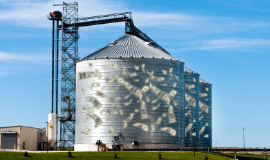Looking to Purchase Equipment to Reduce Your Tax Burden? Consider a Cash Bin Instead!
“My accountant says I need to spend $60,000 before year-end.”
Purchase a Cash Bin Instead of a Grain Bin.

One pushback I get from some clients is that if they need to liquidate or sell that pickup they can, but not the retirement account. I never encourage clients to liquidate a retirement plan, but let’s consider the worst-case scenario. Let’s say after 5 years you need access to that cash. At this time, the value (using return assumptions above) is now worth 106,696 If you withdraw money from your 401K before you’re 59 1/2, the IRS usually assesses a 10% penalty. So, if you withdraw $106,696 from your 401k you would have a $10,669 penalty (and pay taxes on the income). So, based on a penalty of 10% you would receive $96,027 after the 10% penalty. Not a bad investment. I know that farm equipment holds its value pretty well, but I’m guessing it would not appreciate that much. The cool thing about the “cash-bin” is that it’s a diversified asset. In the case of the farmer, I was working with, he had very few assets outside of agriculture. If agriculture is in a slump, the assets he is accumulating to fund his retirement are likely worth less. The “cash-bin” is a non-farm income-earning asset (and one could even argue it’s the color green)!
Other Tools to Consider:
- Gifting commodities to charity. A farmer who actively engages in farming can have significant tax savings by donating grain directly to a charity. The charity makes money by selling the donated grain and the farmer gets tax reductions greater than just donating cash.
- Qualified charitable distributions (QCDs) QCDs are a unique tax strategy that allow individuals who are at least age 73 and have traditional and/or inherited IRAs to distribute up to $100,000 per year directly from their IRA to a 501(c)(3) nonprofit with no federal income tax consequences. Gifts made to grant-making foundations, donor advised funds, or charitable gift annuities are excluded from these rules. Making a QCD will reduce the value of your IRA, thereby potentially reducing your RMDs when you are obligated to do so in future years. This is an option for you even if you do not itemize your deductions. Currently, QCDs are limited to $100,000 per year. As a result of the SECURE Act, deductible traditional IRA contributions made beginning at age 73 may reduce your QCD amount. Additionally, if you wish to take a RMD and make a QCD, consider making the QCD first if a RMD is required for the year ("first money out" rule). Please consult with your tax advisor.
- Consider "bunching" charitable contributions - if you regularly give to charity but the standard deduction is greater than your itemized deductions, you can put multiple years of charitable contributions into a donor advised fund (DAF). Then you use the amount contributed to your DAF as a deduction (itemized). In future years, you would make contribution from your DAF and take the standardized deduction. Learn more about charitable giving here.
- Funding a Health Saving Account - you can contribute $3,650 for self-only and $7,300 for families. Additional $1,000 catch up contributions are allowed for taxpayers 55 or older.
- Capital loss harvesting – if you have reportable capital gains, selling securities in your portfolio that would create a loss may help to offset other recognized capital gains. In a year with volatility in the market, this might be a way to take advantage of market swings.


